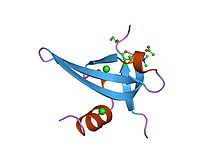| Chromodomain | |||||||||
|---|---|---|---|---|---|---|---|---|---|
 Structure of polycomb chromodomain.[1] | |||||||||
| Identifiers | |||||||||
| Symbol | Chromodomain | ||||||||
| Pfam | PF00385 | ||||||||
| InterPro | IPR000953 | ||||||||
| SMART | SM00298 | ||||||||
| PROSITE | PS50013 | ||||||||
| SCOP2 | 1pfb / SCOPe / SUPFAM | ||||||||
| CDD | cd00024 | ||||||||
| |||||||||
A chromodomain (chromatin organization modifier[2]) is a protein structural domain of about 40–50 amino acid residues commonly found in proteins associated with the remodeling and manipulation of chromatin. The domain is highly conserved among both plants and animals, and is represented in a large number of different proteins in many genomes, such as that of the mouse. Some chromodomain-containing genes have multiple alternative splicing isoforms that omit the chromodomain entirely.[3] In mammals, chromodomain-containing proteins are responsible for aspects of gene regulation related to chromatin remodeling and formation of heterochromatin regions.[4] Chromodomain-containing proteins also bind methylated histones[5][6] and appear in the RNA-induced transcriptional silencing complex.[7] In histone modifications, chromodomains are very conserved. They function by identifying and binding to methylated lysine residues that exist on the surface of chromatin proteins and thereby regulate gene transcription.[8]
- ^ Min J, Zhang Y, Xu RM (August 2003). "Structural basis for specific binding of Polycomb chromodomain to histone H3 methylated at Lys 27". Genes Dev. 17 (15): 1823–8. doi:10.1101/gad.269603. PMC 196225. PMID 12897052.
- ^ Messmer S, Franke A, Paro R (July 1992). "Analysis of the functional role of the Polycomb chromo domain in Drosophila melanogaster". Genes Dev. 6 (7): 1241–1254. doi:10.1101/gad.6.7.1241. PMID 1628830.
- ^ Tajul-Arifin K, Teasdale R, Ravasi T, Hume DA, Mattick JS (2003). "Identification and Analysis of Chromodomain-Containing Proteins Encoded in the Mouse Transcriptome". Genome Res. 13 (6B): 1416–1429. doi:10.1101/gr.1015703. PMC 403676. PMID 12819141.
- ^ Jones DO, Cowell IG, Singh PB (2000). "Mammalian chromodomain proteins: their role in genome organisation and expression". BioEssays. 22 (2): 124–37. CiteSeerX 10.1.1.575.6410. doi:10.1002/(SICI)1521-1878(200002)22:2<124::AID-BIES4>3.0.CO;2-E. PMID 10655032.
- ^ Nielsen PR, Nietlispach D, Mott HR, Callaghan J, Bannister A, Kouzarides T, Murzin AG, Murzina NV, Laue ED (2002). "Structure of the HP1 chromodomain bound to histone H3 methylated at lysine 9". Nature. 416 (6876): 103–7. Bibcode:2002Natur.416..103N. doi:10.1038/nature722. PMID 11882902. S2CID 4423019.
- ^ Jacobs SA, Khorasanizadeh S (2002). "Structure of HP1 chromodomain bound to a lysine 9-methylated histone H3 tail". Science. 295 (5562): 2080–3. Bibcode:2002Sci...295.2080J. doi:10.1126/science.1069473. PMID 11859155. S2CID 38589662.
- ^ Verdel A, Jia S, Gerber S, Sugiyama T, Gygi S, Grewal SI, Moazed D (2004). "RNAi-Mediated Targeting of Heterochromatin by the RITS Complex". Science. 303 (5658): 672–6. Bibcode:2004Sci...303..672V. doi:10.1126/science.1093686. PMC 3244756. PMID 14704433.
- ^ Yap KL, Zhou MM (March 2011). "Structure and mechanisms of lysine methylation recognition by the chromodomain in gene transcription". Biochemistry. 50 (12): 1966–80. doi:10.1021/bi101885m. PMC 3062707. PMID 21288002.